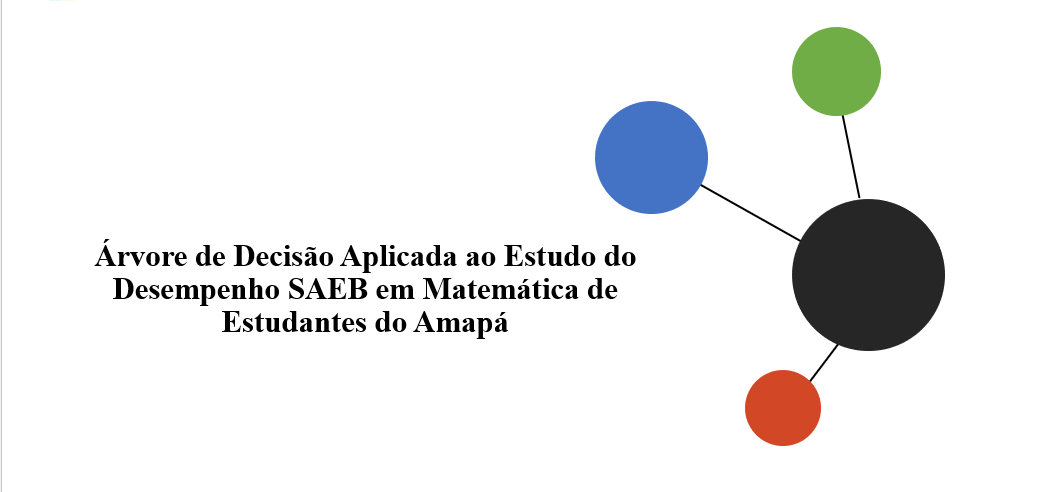Decision Tree Applied to the Study of SAEB Performance in Mathematics of Students from Amapá
Keywords:
SAEB, Classification Tree, Amapá, High schoolAbstract
SAEB is a national assessment that measures student performance in Portuguese and Mathematics in Basic Education. SAEB results provide data for monitoring and improving the quality of education in the country. The Amapá Mathematics Education Research Group – GEMAP, linked to the Federal University of Amapá, began a series of studies on SAEB regarding student performance in Mathematics and Portuguese with a focus on Amapá and the Norte region of Brazil. The objective of this study is to estimate profiles of students from Amapá below the national average who participated in the SAEB test. As a methodology, the classification tree algorithm, CHAID method, was used, with a sample base of 9462 students from Amapá, year 2019, the database was downloaded from the INEP website. It was observed that 68.5% of students are below the national average (277,3 points in Mathematics in 2019), regarding profiles, the classification tree indicated that the profiles with the highest probability of being below average are students from “public schools that live in an area rural” with 83,7%. The study helped to show which profiles are most likely to have below average grades in mathematics and thus contribute to the formulation of public educational policies.
References
DIAZ, M. D. M. (2012). (Des)igualdades de oportunidades no ensino médio brasileiro: Escolas públicas e privadas. Economia, 13(3a), 553-568. Disponível em: https://www.anpec.org.br/revista/vol13/vol13n3ap553_568.pdf.
GUSMÃO, F. A. F.; AMORIM, S. S. Desigualdade educacional no ensino médio brasileiro. Educação, v. 47, n. 1, p. e108, 2022. Disponível em: https://www.researchgate.net/profile/Fabio-Alexandre-Ferreira-Gusmao/publication/ 365703210_Desigualdade_educacional_no_ensino_medio_brasileiro/links/ 637f2a281766b34c544f182a/Desigualdade-educacional-no-ensino-medio-brasileiro.pdf.
INEP. Microdados do INEP, 2024. Disponível em: https://www.gov.br/inep/pt-br/acesso-a-informacao/dados-abertos/microdados
INEP. Resultados do SAEB, 2019. Disponível em: https://undime.org.br/noticia/16-09-2020-09-24-inep-divulga-resultados-do-saeb-2019.
LAPEI UFG. Uso de dados na pesquisa: qual a diferença entre dados primários e secundários?. 2024. Disponível em; https://lapei.face.ufg.br/p/43695-17-uso-de-dados-na-pesquisa-qual-a-diferenca-entre-dados-primarios-e-secundarios
Pestana, M. H; Gageiro, J. N. (2009). Análise categórica, árvores de decisão e análise de conteúdo em ciências sociais e da saúde com o SPSS. Lisboa; Porto: Lidel, D.L. 2009. - XVIII, 551, [7] p. : il. ; 24 cm. - (Estatística). - Bibliografia, p. 543-546. - ISBN 978-972-757- 585-5.
Silva, E. L. da.; Menezes, E. M. Metodologia de pesquisa e elaboração de teses e dissertações, 2005. 4. ed. rev. atual. Universidade Federal de Santa Catarina – UFSC. Florianópolis 2005.
Soares, J. F; Xavier, F. P. Pressupostos educacionais e estatísticos do IDEB, 2013. Educ. Soc., Campinas, v. 34, n. 124, p. 903-923.

Downloads
Published
How to Cite
Issue
Section
License
Proposta de Política para Periódicos de Acesso Livre
Autores que publicam nesta revista concordam com os seguintes termos:
- Autores mantém os direitos autorais e concedem à revista o direito de primeira publicação, com o trabalho simultaneamente licenciado sob a Licença Creative Commons Attribution que permite o compartilhamento do trabalho com reconhecimento da autoria e publicação inicial nesta revista.
- Autores têm autorização para assumir contratos adicionais separadamente, para distribuição não-exclusiva da versão do trabalho publicada nesta revista (ex.: publicar em repositório institucional ou como capítulo de livro), com reconhecimento de autoria e publicação inicial nesta revista.
- Autores têm permissão e são estimulados a publicar e distribuir seu trabalho online (ex.: em repositórios institucionais ou na sua página pessoal) a qualquer ponto antes ou durante o processo editorial, já que isso pode gerar alterações produtivas, bem como aumentar o impacto e a citação do trabalho publicado (Veja O Efeito do Acesso Livre).
